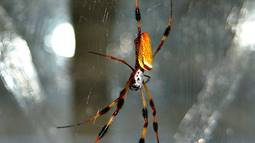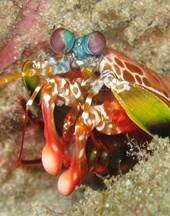Astonishing Materials and an Amazing Arachnid
 Argonne National Lab: Jeff Yarger.
Argonne National Lab: Jeff Yarger.
A Nephila clavipes female spider in the center of her web. The radial strands and scaffolding of her web is composed of major and minor ampullate spider silk fibers. Commonly referred to as dragline silk, this substance was imaged at the nanoscale at Argonne’s Advanced Photon Source.
"This life is not an easy one," says actor Andrew Garfield, playing Peter Parker in the soon-to-be released movie (July 3rd), The Amazing Spider-Man.
That's true. And that's why researchers supported by the Department of Energy's Office of Science are studying and developing materials strong enough to withstand daily batterings and perhaps even unexpected assaults by arch-villains and über-beasts like the Lizard.
For instance, researchers at Argonne National Laboratory (Argonne Lab) recently used its extremely bright light, the Advanced Photon Source (APS), to unravel a few more mysteries about spider silk. Spider silk is amazing stuff, astonishingly flexible and still incredibly tough—pound for pound, its stronger than steel. So Argonne Lab researchers used the APS to look at the structure of dragline silk, which allows arachnids to swing from branches and dangle window frames, the Spiderman equivalent of swinging from high buildings and dangling from Gotham's towers.
The strength and flexibility of dragline silk comes from two different regions: Crystalline lattices, about ten percent of the material, are what make it stronger than steel; and "amorphous" regions, the other 90 percent, give it its amazing flexibility. However, the APS analysis showed that the amorphous regions of the silk are even more disordered than previously thought, that even at the nanoscale, the atoms and proteins there are tangled and disorganized. That insight, in turn, could lead to better ways to synthesize new sets of ultra-strong materials—perhaps even fabrics that Peter Parker could wear in the all-but-inevitable sequel.
When that sequel comes, it's nearly certain that Spiderman won't face off against the peacock mantis shrimp. However, the crustacean has incredible claws, which scientists recently took a look at using the National Synchrotron Light Source at Brookhaven National Lab. The critter's fearsome claws can accelerate to speeds faster than a .22-caliber bullet and smash through mollusk shells and even aquarium glass without injury. It can also punch up to 50,000 times before being replaced, and it simply grows back if removed.
Brookhaven Lab's analysis showed that the claw's incredible strength and astonishing durability comes from a combination of three unique layers, which allow small cracks to form, but prevent them from spreading. That insight could lead to a whole host of lighter and stronger materials, with potential applications in everything from the medical to the military sciences.
 Brookhaven National Lab: Silke Baron
Brookhaven National Lab: Silke Baron
A mantis shrimp shows off its fist-like clubs, which can accelerate underwater faster than a 22-caliber bullet.
Speaking of strength and durability, researchers at Oak Ridge National Laboratory (ORNL) recently won an R&D 100 award—an "Oscar" of innovation—for their creation of NanoSHIELD Coatings (Nano-Super Hard-Inexpensive-Laser Deposited Coatings). The coating is created by a laser fusing a unique, iron-based powder with virtually any type of steel. Objects with the NanoSHIELD coating have a wear resistance two to ten times greater than those coated in conventional fashion. As a consequence, NanoSHIELD can extend the life of costly cutting and manufacturing tools—such as those used in tunnel boring and construction—by more than a fifth, potentially saving projects millions of dollars.
The makers of Spiderman the movie hope to do well at the box office—and they probably will. But the scientists working on spidery applications in real life—instead of reel life—hope to do even better. They're studying and developing materials that could improve the lives of Americans in profound ways, keeping our soldiers safer, our citizens healthier and our economy stronger.
This life is a hard one. But thanks to the tough and enduring materials being developed by researchers in the Office of Science, it will hopefully become a bit easier for everyone.
The Department's Office of Science is the single largest supporter of basic research in the physical sciences in the United States, and is working to address some of the most pressing challenges of our time. For more information about the labs mentioned, please visit Argonne Lab http://www.anl.gov/, Brookhaven Lab http://www.bnl.gov/world/ and Oak Ridge National Laboratory http://www.ornl.gov/.
Charles Rousseaux is a Senior Writer in the Office of Science.

